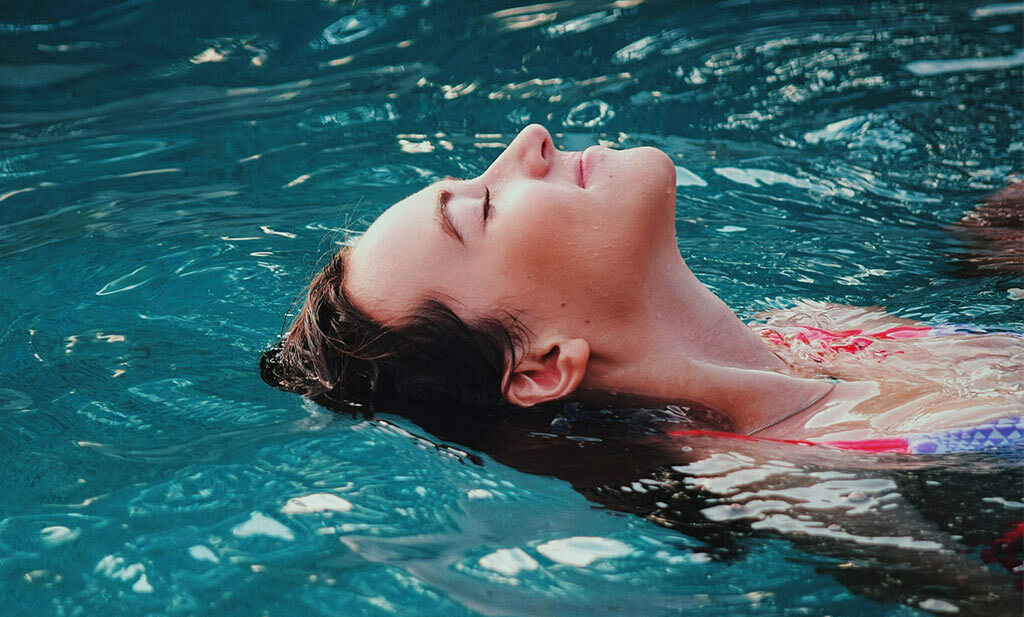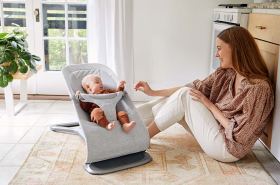
There’s few things more exciting than feeling your baby growing bigger and bigger in your belly. However, as they grow there is more and more weight to carry around with you – and that can be exhausting. One way to relax is to take a bath during pregnancy, with candlelight and soft music. Or perhaps you’d prefer a day at the spa to use the sauna, hot tub or even swim a few lengths. But sometimes rumours can be confusing and you might have heard some about bathing and pregnancy.
So, is it safe? Should you be worried about overheating, strain on your body, the risk of bacteria etc.? Yes and no, says our expert and midwife Katrin Ritter. In principle, there is nothing wrong with taking a bath or swimming during pregnancy and exercise is generally good for you. However, there are a few things to bear in mind before you throw yourself into the water while pregnant.
Bathing and pregnancy
Let’s first take a look at the question “can you have a bath when pregnant”? The short answer is… Yes! For many, taking a bath can be your own little wellness oasis at home during pregnancy. Warm water, bubble bath, candlelight, relaxing music… This is exactly how it should be – especially when you are pregnant. Because the warm water loosens your muscles, relieves pressure on your joints and relaxes your back.
Bathing and pregnancy – how hot should a bath be when pregnant?
However, the water temperature is crucial! A comfortable around 37 degrees should not be exceeded. / It shouldn’t be warmer than body temperature and slightly below is better. Water that is too warm can dilate the blood vessels, lower blood pressure and lead to circulatory problems. And you certainly don’t want to risk falling in or next to the bath. In addition, higher water temperatures can also aggravate varicose veins and your core body temperature could rise if you spend too long in a hot bath. And this is particularly risky when bathing during pregnancy in the first trimester. This is because the risk of premature birth or malformations of the embryo have been linked to an increased core body temperature of the birthing parent.
Bathing and pregnancy – here’s how it works
A 15-minute bath at the maximum water temperature is good for you (assuming a healthy pregnancy). You should avoid using pure essential oils in the bath, or discuss this with your midwife first. This is because some can have a labour-promoting effect. There is also a risk of slipping in the bath with oils. So be careful. On the other hand, certain bubble baths can be moisturising, which is good for your skin.
Another important tip from us to you: Never bathe when you are home alone! An adult should always be within calling distance so that they can help if you need them. Please also have a bottle of water within easy reach. Because hydration is always important, especially when bathing during pregnancy!

Swimming during pregnancy
Swimming is all about taking advantage of your body’s weightlessness and moving in a way that is easy on your joints. Because exercise is good for you. And this applies from early pregnancy right through to delivery (with a few exceptions, but more on that later). Especially in the third trimester, everything inside you simply breathes a sigh of relief when you let yourself slide into the water. The extra weight is taken off your back and joints and you feel as light as a feather. Let yourself drift and relax, but also enjoy swimming one or two laps – depending on how you feel. Be sure to listen to your body, it will tell you what you’re capable of.
Swimming during pregnancy – things to bear in mind
One outdated school of thought is that swimming during pregnancy can lead to premature labour. However, in many cases it even reduces the risk of premature birth, according to one study. You also improve your stamina and your ability to recover from exertion. Sounds pretty ideal for what you’ll be facing during pregnancy, labour and afterwards, doesn’t it? If you do your lengths regularly, you can also prevent possible disc problems and reduce water retention. And because your brain is properly supplied with oxygen, swimming training also keeps you mentally fit. Because you sweat faster when pregnant , the water also offers a welcome cooling effect. And last but not least, the gentle exercise will also get your bowels moving. During pregnancy, your bowels tend to become a little sluggish.
Swimming during pregnancy – do’s and don’ts
When swimming, it doesn’t matter how you move in the water. Whether it’s breaststroke or backstroke, aqua aerobics or slow aqua spinning – do what’s good for you. The only thing you should avoid is jumping into the water. Because with every week that you are pregnant, the focus is more on your stomach. So if you land belly first in the water, you could injure yourself and your unborn child.
The aim is not to achieve peak performance. On the contrary, your heart rate should remain in the moderate aerobic range, i.e. between 100 and 135 beats per minute. However, this depends on your ‘training status’. You should therefore discuss this with your midwife or doctor. However, as long as you do a few laps at a leisurely pace, everything should usually be okay. If you suddenly feel strange for whatever reason, make sure you take a break and contact the pool staff. Better safe than sorry.
Speaking of breaks:we recommend leaving about 24 hours between swimming sessions. Your ligaments and muscles are looser than usual due to the pregnancy hormone relaxin, so there is a risk of injury even when swimming if you don’t recover sufficiently.
Incidentally, you don’t have to worry about any bacteria in public pools. The water is thoroughly purified and monitored, and the chlorine in it is effective against germs. Only if you are somewhere that smells very, very strongly of chlorine is this often a sign of contaminated water. You should generally avoid swimming there.
Natural waters, hot tubs and spas
While splashing around in the bathtub at home or in a public swimming pool is not a cause for concern, it can be a different story in lakes, rivers, spas and whirlpools. In other words, it is worth taking a closer look at the situation in question.
Natural waters – swimming in lakes, rivers and seas
If you are in an area that is safe to swim and the water quality is very good at the time of your visit, you can go swimming without hesitation. In summer, blue-green algae, E. coli or vibrio bacteria can multiply in stagnant waters. An infection with the latter can lead to diarrhoea, chills and fever, for example, and even sepsis in immunocompromised people. So always find out about possible bathing warnings in advance and take them seriously. Surfers Against Sewage have a real-time map you can use to track sewage discharge and pollution risks around the UK. They also have a free Safer Seas & Rivers Service (SSRS) app.
Even in natural waters, you should never go swimming pregnant alone, but always have an adult at your side who can help you in an emergency. Pay particular attention to currents and tides. When you’re pregnant, you have to move additional weight through the water due to your baby bump.
Hot tubs – should a pregnant woman go in a hot tub?
Bacteria and fungi thrive in hot tubs as they are filled with warm water which is the perfect environment for them to multiply quickly. The water itself is also changed infrequently. As the local immune defence of the vaginal flora is weakened by pregnancy hormones, bathing in a hot tub can lead to a fungal infection. And pregnant people should urgently avoid this, especially in their first trimester. You may also choose to avoid them because of the risks of overheating, dehydration and fainting, particularly in the first 12 weeks of pregnancy.
Visiting the spa – can you use a sauna while pregnant?
As we’ve already discussed, anything that can affect your circulation or involves high temperatures should be treated with caution. This includes thermal baths. In principle, however, a visit to the thermal baths is not a problem as long as you avoid excessive temperature changes and only stay in the water for a short time.
When it comes to saunas, for example, a Finnish sauna at 90 degrees should be avoided by pregnant people. Better: the bio (more gentle) sauna or a steam room and only have short sessions, but only if you have been a sauna-goer before you got pregnant. You should also skip the cold pool and instead cool yourself after the sauna session with a hose or shower. Start with your feet and hands first, then your legs and arms and finally, your back and stomach. And don’t worry, your baby won’t feel a thing, they are perfectly protected by the abdominal wall, uterus and amniotic fluid.
You should take sufficient breaks between the individual heat or cold sessions. Take it slow and easy to protect your circulation,body and your mucus plug that glands on the cervix form at the beginning of pregnancy. It closes the cervix and serves as a natural protective barrier for germs, helping to prevent them from entering the uterus.
When should you NEVER swim or bath in pregnancy?
As with all topics during pregnancy, there are also a few situations in which you should refrain from swimming and bathing during pregnancy. In some cases, this also applies to exercise in general. However, please always discuss this with your midwife or doctor/consultant if you have one. They will always know what’s best for your specific circumstances.
Swimming and bathing during pregnancy should be avoided in certain circumstances such as in the case of:
- bleeding
- premature labour
- high-risk pregnancy
- nausea
- dizziness
Yay, despite potential uncertainties and one or two pregnancy myths, swimming, bathing and pregnancy are a great mix. With a few exceptions designed to keep you and baby safe so you can just enjoy your little weightless break in the bathtub, swimming pool or lake. And very important: Ask your midwife or gynaecologist for advice if you have any uncertainties or health restrictions!
Featured photo from: 📷 Haley Phelps , Unsplash



